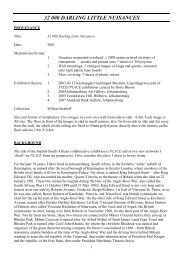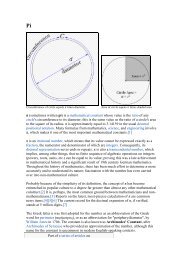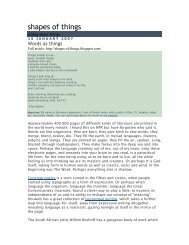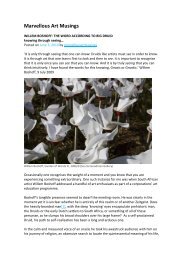Miranthe Staden Garbett Report - Willem Boshoff
Miranthe Staden Garbett Report - Willem Boshoff
Miranthe Staden Garbett Report - Willem Boshoff
Create successful ePaper yourself
Turn your PDF publications into a flip-book with our unique Google optimized e-Paper software.
Far Far Away is an installation of maps that traverse the personal, political and global.<br />
Dealing with the life of <strong>Boshoff</strong>’s grandfather, the South African War of 1899-1902 and<br />
his own Afrikaner heritage, this piece consists of various maps locating <strong>Boshoff</strong>’s<br />
grandfather’s home town and British concentration camps from different aerial<br />
perspectives. While ethnocentricity underpins both the Boer’s battle for sovereignty,<br />
and the horrors of the British concentration camps, which held women and children,<br />
<strong>Boshoff</strong> goes one step further. <strong>Boshoff</strong> (2007: 28) elaborates:<br />
it was not just my grandfather who had been taken prisoner but 32 000 innocent<br />
children … so I turned my grandfather into a kind of superhero by taking him<br />
straight up into the air, initially hovering over his farm. But he keeps on travelling,<br />
up to 100 kilometers above the earth. From that vantage point he starts to see<br />
more of the global reality. When you are close to your farm all you can see is your<br />
farm, and you know only so much… I wanted my grandfather to have what I have<br />
had the chance to do: to rise above and see the big picture. I made him go a few<br />
thousand miles above the earth, so that he could see the world as a little ball.<br />
In this way <strong>Boshoff</strong> shows how, through a process of inclusion and transcendence,<br />
greater perspectives might be gained without negating the former. Thus he has arrived<br />
at a method for visualising a worldcentric view and his critique is not for its own sake,<br />
but firmly rooted in the service of transcendence and healing.<br />
The same intent and discipline could be said to apply to Children of the Stars (2009), an<br />
artefact encoded with “the agency of the being that created it”, and distinguished by<br />
“the conscious attention that went into its design” (Wilber 2005: disc 1:9). Wilber<br />
defines an artefact as an intentional creation, as opposed to a heap, which is an<br />
accidental conglomeration (2005: disc 1: 7). Children of the Stars is a site-specific<br />
artwork and artefact, installed in June 2009 at the Nirox Foundation in Mogale City of<br />
Human Origin. It consists of six magnificently polished black granite boulders, ranging








